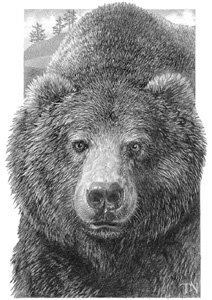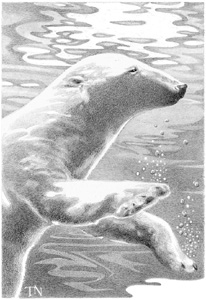Owls Aren't Wise and Bats Aren't Blind (40 page)

Another difference between the two subspecies is color. As its common name indicates, the coastal brown bear varies from light to medium brown. The grizzly, on the other hand, is darker and has white tips on the hairs of its back, in particular. This intermingling of dark and white presents the grizzled aspect from which the bear gets its name.
The coastal brown bears, and the inland grizzlies of Alaska and Canada, seem to be holding their own in most areas. Grizzlies in the lower forty-eight states are another matter. Relentlessly persecuted for years, like the wolves, grizzlies have been reduced to a small fraction of their former numbers and range in the American West.
As previously mentioned, the only two major concentrations of inland grizzlies in the lower forty-eight states are in and around the Yellowstone and Glacier National Park systems. Now, however, the U.S. Fish and Wildlife Service hopes to reintroduce grizzlies into the Selway-Bitterroot area along the Idaho-Montana border, where the last of their kind were exterminated over fifty years ago. By reintroducing twenty-five to thirty grizzlies over the next five years, biologists hope eventually to see as many as three hundred of the big bears inhabiting the area. With 5,700 square miles of designated wilderness on public land in this region, it’s the only remaining area in the lower forty-eight states capable of supporting such a restoration. As with so many other endangered species, the fate of the grizzly rests on the maintenance of adequate habitat.

Brown (grizzly) bear
THE POLAR BEAR
The extraordinarily barren, frigid world of the polar bear
(Thalarctos maritimus)
is nothing like that of black or brown bears. It follows, then, that the polar bear is a vastly different bear from its North American relatives— indeed, from all other bears. Living in such a harsh environment requires the polar bear to have numerous adaptations, some of which are truly amazing!
The polar bear’s species name,
maritimus,
correctly designates it as the seagoing bear, a creature at home not only along the ocean but in it, so its adaptations begin with this central fact of its existence. Polar bears float easily and are powerful, almost tireless swimmers. Individuals have been sighted by ships, miles from shore and swimming with apparent ease, in water so frigid that most creatures, including humans, would perish in it within minutes. It even appears that these remarkable seafarers can sleep while at sea!
The reason for this amazing endurance resides in the bear’s underfur. This coat is so dense that it traps a great deal of air, which lends its owner the buoyancy needed to swim long distances with such ease. Perhaps even more important, it serves to keep water away from the bear’s skin, thus effectively insulating it from the icy ocean. Added to buoyancy and insulation, the polar bear’s huge front paws, edged with stiff hairs to make them even wider, act as great paddles to propel the owner easily through its aquatic environment.
Not surprisingly, polar bears subsist almost entirely on meat, for plant materials are scarce in this great bear’s habitat. Berries and other plant foods are consumed when available, but the seal is the polar bear’s main food supply. Such things as nesting birds and their eggs, as well as stranded whales, supplement the bear’s diet.
Polar bears can be incredibly patient hunters, waiting for hours beside a seal’s breathing hole to dispatch the seal when it comes up for air. They will also stalk seals on the ice by doing what one scientist terms “otter travel,” in reference to the otter’s rather humpy land gait, which tends to emphasize the height of the hindquarters. In this mode, the bear flattens its head and front quarters against the ice, tucks its front paws beneath it, and propels itself slowly toward the seal with its hind feet and slightly elevated rump. The sight of this huge beast creeping forward in such a strange position must indeed be an astonishing one!
In addition to their other remarkable aquatic skills, polar bears can also dive to a depth of up to fifteen feet. They sometimes use this ability to pursue an escaping seal, or to swim underwater to reach a seal basking on an ice floe: at the edge of the floe, the bear hurls itself out of the water to seize its prey.
The coastal brown bear is the world’s largest bear, right? Not so fast—some knowledgeable scientists aren’t so sure. They think that the polar bear at least equals the brown bear in size, and may occasionally exceed 1,600 pounds. Understandably, reliable polar bear weights are hard to come by; given the remoteness of most polar bears, weighing them, alive or dead, can be a daunting proposition. For the present, then, we can think of the brown and polar bears as Their Ursine Majesties, sitting atop thrones of equal height as the planet’s largest land carnivores.
Almost everyone knows that polar bears are white—but almost everyone is wrong! The polar bear’s white appearance is part of an astounding twin adaptation that allows the bear to survive and function in a land of almost unimaginable cold. The first adaptation is in the bear’s long outer hairs. The center of each hair conducts light, much like a fiberoptic strand. Some of this light filters through the translucent outer part of the hair, making it
appear
white, although it doesn’t have pigment to make it truly white. The second adaptation is black skin, which readily absorbs the heat from the sunlight filtering down through the centers of the hairs. These adaptations are highly unusual, although not unique, for arctic foxes and seal pups also share them.
These adaptations combine to give the polar bear the best of two worlds, as it were. Without the white-appearing coat’s camouflage, it would be extremely difficult for the great predator to stalk and kill its prey in a largely white world. Also, lacking the black skin underneath to absorb the heat of the Arctic sun during that part of the year when it’s visible, the bear would require a great deal more energy to keep itself warm. Working in tandem, these wonderful adaptations help ensure the polar bear’s success in its forbidding environment.
Although polar bears have been known to attack people, and certainly should be considered dangerous, scientists believe that they’re far less aggressive and temperamental than inland grizzlies. They’re certainly not afraid of humans and may approach out of curiosity, with no aggressive intent; some have likely never laid eyes on one of our species before, which might also be a cause of their curiosity. Some polar bears, however, are highly aggressive, so all of them should be regarded as armed and dangerous. As proof of this, an Inuit campsite on the western shore of Hudson Bay was recently attacked by a polar bear. A woman was killed, and a man and boy were seriously injured.
Like the brown bear, the polar bear breeds only every third year. It usually has two cubs, though occasionally only one. The female dens before giving birth, although the word
den
can be something of a misnomer in the polar bear’s case. Often the female will dig a den in a snow bank or a peat bed, but sometimes she’ll simply curl up in the snow and allow falling and drifting snow to cover her deeply enough so that a small but snug cavity is formed. Remarkably, males, as well as females with cubs, don’t den, but remain active through the incredibly bitter arctic winter!
Because polar bears, unlike their black and brown cousins, are completely exposed to view, attacks by male polar bears on cubs, as well as the mothers’ defense of them, are well documented. According to Gary Alt, their method of attack is vastly different from that of brown and black bears. In the case of the latter two, the attack is a savage rush that is quickly over. Either the female successfully defends her cubs against the oncoming male, or he kills one or more of them. With polar bears, since the female and cubs are visible at all times and have no place to hide, the process is a long, slow stalk covering mile after mile.
While the male stalks behind, the female keeps a watchful eye on him as the cubs hold tight to her flanks. Every so often, when she loses patience, the female turns and charges the male. Amazingly, the cubs charge with her in a move that Alt says is so beautifully choreographed that it’s as if only one body were moving, instead of three!
Only rarely does a cub separate from its mother, in which case it’s usually seized and killed by the male. More commonly, however, the female, with cubs glued to her sides, charges the male every little while, persevering until the male at last gives up and goes away.
On the whole, our three North American bears seem to be thriving. No longer viewed as nuisance animals, or worse, to be eradicated as quickly as possible, they’re now being seen for what they are—fascinating, immensely powerful predators that have a place in the scheme of things. True, grizzlies in the American West still have many detractors and are controversial, but a rapidly growing number of supporters seek to retain them or reintroduce them where possible. As large, free-roaming predators, all three species depend on major blocks of suitable habitat as the key to permanent survival. As long as we protect and maintain such habitat, these magnificent animals will continue to be a part of our world.

Polar bear
22
The Comeback Kid: The White-tailed Deer
MYTHS
 Deer have horns.
Deer have horns.
 A deer’s age can be told from its antlers.
A deer’s age can be told from its antlers.
 The deer’s breeding season is brought on by cold weather.
The deer’s breeding season is brought on by cold weather.
 Newborn fawns have no scent.
Newborn fawns have no scent.
 A fawn found alone is probably orphaned.
A fawn found alone is probably orphaned.
 A doe will abandon her fawn if humans have touched it.
A doe will abandon her fawn if humans have touched it.
 Deer make good pets.
Deer make good pets.
 Deer are quite tall.
Deer are quite tall.
 Deer are fragile and easily injured.
Deer are fragile and easily injured.
 A winter deer yard is much like a woodland barnyard.
A winter deer yard is much like a woodland barnyard.
 Deer live many years in the wild.
Deer live many years in the wild.
 Small dogs pose little threat to deer.
Small dogs pose little threat to deer.
 When the snow becomes deep, it’s time to start feeding deer.
When the snow becomes deep, it’s time to start feeding deer.
IF A POLL WERE TAKEN TO DETERMINE NORTH AMERICA’S SINGLE MOST IMPORTANT MAMMAL, IT WOULD SURELY BE THE WHITE-TAILED DEER
(ODOCOILEUS VIRGINIANUS).
Nearly ubiquitous and highly adaptable, it can be found in almost every imaginable habitat: farmland, brush, deep forest, desert, swamp, suburb, and sometimes even in rather densely populated portions of cities throughout most of the lower forty-eight states and the southern third of Canada. Moreover, deer are abundant, often excessively so, throughout most of their range, so that they’ve become a familiar part of the daily lives of countless millions of people.
